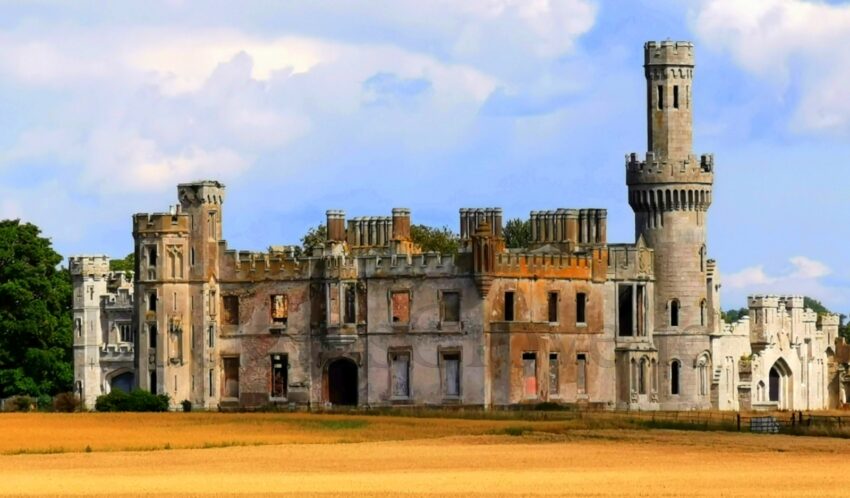Duckett’s Grove was originally a three-storey over basement Georgian country house built circa 1745. Traces of this Georgian style can still be observed in the entrance block and front face. It replaced a smaller house on the same site and was re-designed and extended by British born Architect Thomas A. Cobden at the request of John (Dawson) Duckett (1) circa 1825. At this stage the Gothic style mantle was added, including the profound ornamentation, arches, turrets, crenellations and an octagonal viewing tower to the north.
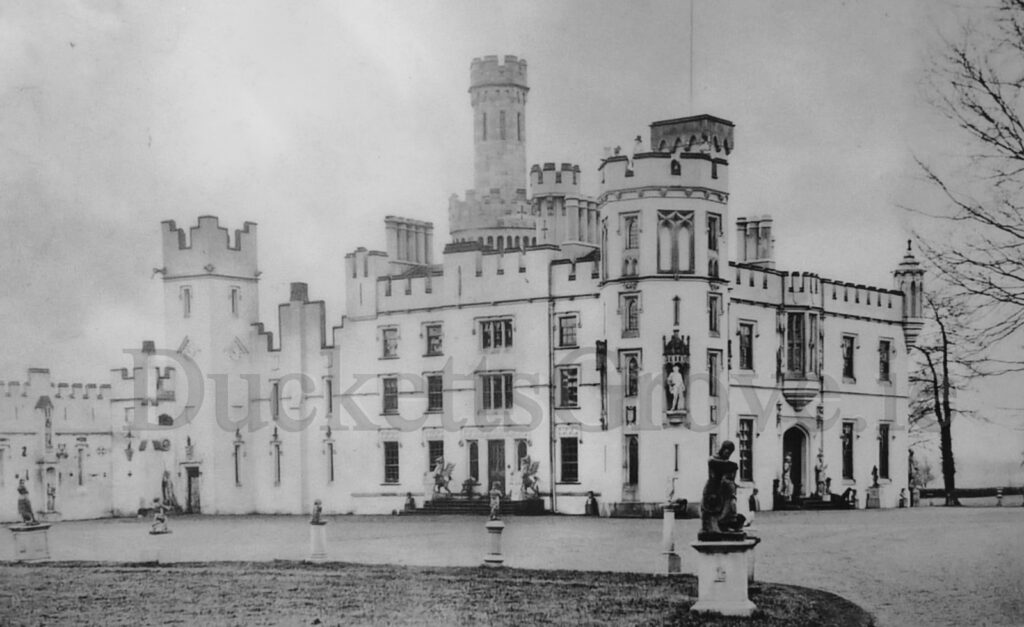
Gothic Architecture and Design
Gothic style architecture represented giant leaps from previous, relative basic buildings. Gothic architecture is an architectural style that was particularly popular in Europe from the late 12th to the 16th century, surviving into the 17th and 18th centuries in some areas. It evolved from Romanesque architecture (06th to 11th century) which was succeeded by Renaissance architecture (14th to 17th century). Gothic is a particular style of masonry building characterised by cavernous spaces with the expanse of walls broken up by overlaid tracery. Feature of Gothic architecture include rib vaults, flying buttresses, crenellations, gargoyles and pointed (Gothic) arches, used as a solution to the problem of building very tall structures, while preserving as much natural light as possible. The pointed arch relieved some of the thrust, and, therefore, the stress on other structural elements. Its form distributed the force of heavier ceilings and thick walls and could support much more weight than previous simple designs. Gargoyles, while highly decorative, were often used as water spouts to remove water from the roof as well as to provide symbolic spiritual protection for the property and its inhabitants. The Gothic arch was also aesthetically pleasing and noted for its beauty which influenced many other features of Gothic design, such as the vaulted ceiling. Gothic design, infused with the original Georgian country house design, is clearly visible in the re-design of Duckett’s Grove by Thomas A. Cobden.

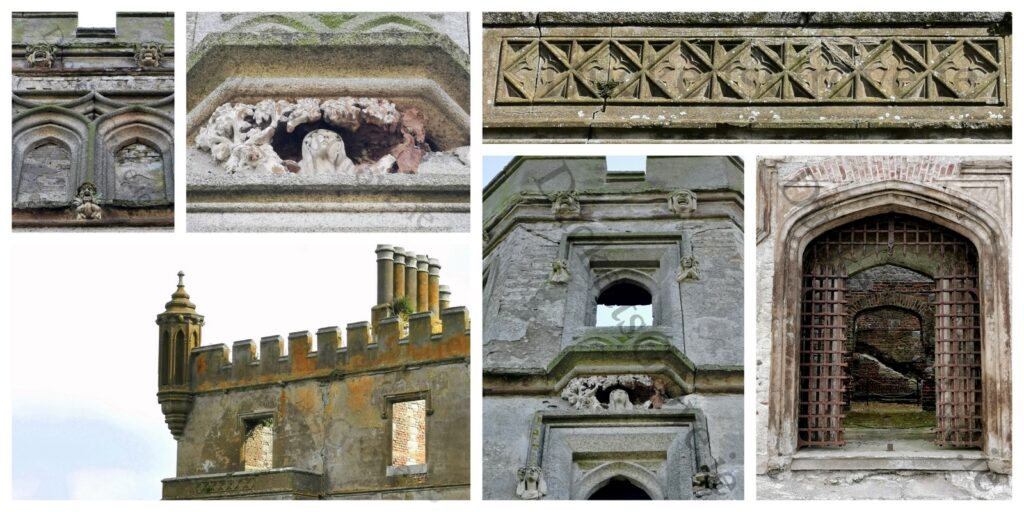
Thomas A. Cobden (1794-1842)
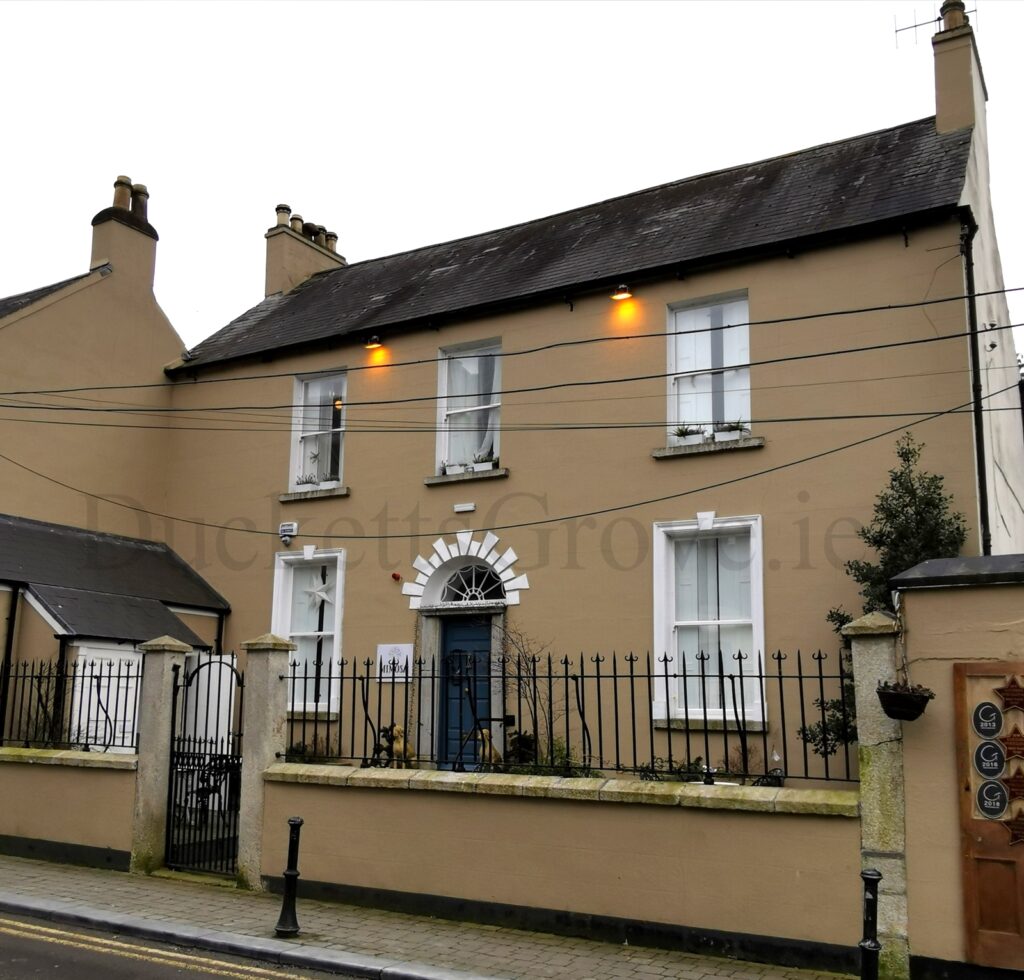
Thomas Alfred Cobden (1794-1842) was an Architect and builder, of London and Carlow and is said to be the son of Thomas Cobden, a builder in Chichester, England, who built Chichester Market House in 1807, with business partner William Brooks. Thomas Cobden senior was a widower when he married Mary née Camp. Their son Thomas Alfred Junior was baptised on 8th July 1794, at an independent chapel in Chichester. In 1821 he married Ann Fleming at St. James’s Westminster, England. They had two sons and two daughters.
Thomas A. Cobden designed his own house, where he lived for some time in Carlow on what was Chapel Lane, now named College Street. From 1832 he lived in London until his death in 1842 at the age of forty-eight. He was buried on the 3rd December 1842 in Abney Park Cemetery, Stoke Newington, Middlesex, England. His will was proved in the Prerogative Court of Canterbury on 16th January 1843.
All of his Irish commissions and works were carried out in the counties of Carlow and Wexford. Examples of his County Carlow designs can be identified in buildings such as Russellstown Park House, the Cathedral of the Assumption, St. Patrick’s College, Oak Park House, Holy Cross Church Killeshin, Ballykealy House, Carlow, Bagenalstown Railway Station and Adelaide Memorial Church Myshall. His clients included John (Dawson) Duckett (1), William (Dawson) Duckett (1), Robert Clayton Browne, General Robert Browne Clayton, Thomas Elrington, the Bishop of Ferns, James Doyle, the Bishop of Kildare and Leighlin (JKL). (Source of reference on Thomas A. Cobden is courtesy of Dictionary of Irish Architects www.dia.ie)

Duckett’s Grove is further extended – circa 1845
In circa 1845, Duckett’s Grove Gothic mansion was further extended. This extension was designed by John McDuff Derick Architect (1810-1859) from Ballymote, Co. Sligo who added the granite ashlar viewing tower on an octagonal plan to the south, turrets, entrance screens and stable complex to the rear.
Renaissance Architectural Design
The design by John MacDuff Derick comprises of Renaissance architectural design (14th to 17th century), while also incorporating and continuing the existing Gothic design (12th to 16th century). Renaissance architects placed emphasis on symmetry, proportion, geometry, and regularity, as demonstrated in classic Roman Architecture. It fused classical Roman technique with Renaissance aesthetics, with several foundational architectural concepts; facades, columns, pediment (a classical architecture consisting of triangular section or gable), and pilasters (a rectangular column that projects partially from the wall to which it is attached, giving the appearance of a support, but is only for decoration), arches, vaults, domes, windows and walls. Roman architecture was an important aspect of Renaissance architecture which became more decorative and ornamental with a wide spread use of statuary, domes, columns, pilasters and lintels, as well as niches, cupolas and semi-circular arches. Many of these features from the Renaissance period can be found in the extended design of Duckett’s Grove by John MacDuff Derick.
Design Periods
Romanesque period: 06th to 11th century
Gothic period: 12th to 16th century
Renaissance period: 14th to 17th century
Baroque period: 17th to 18th century
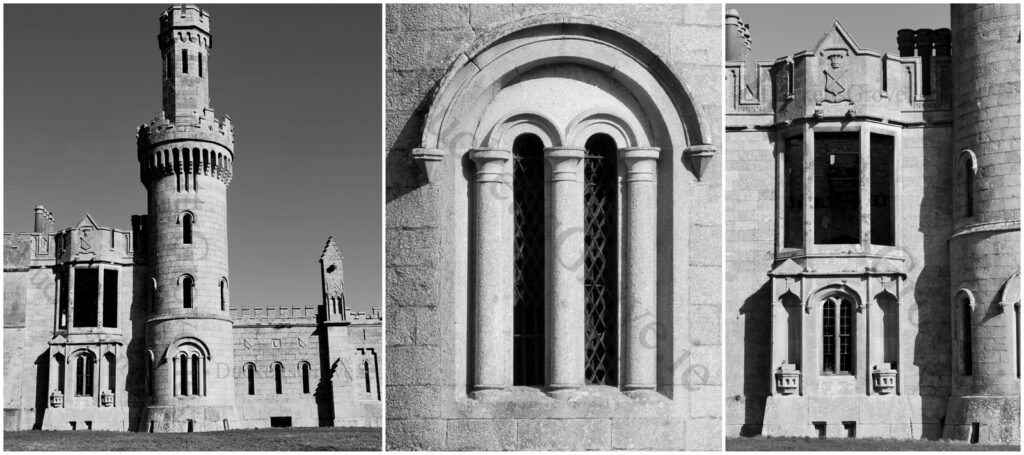
One of the most elaborate features of the extension design of John MacDuff Derick, and what remains the most recognised feature of Duckett’s Grove, is the granite ashlar viewing tower on an octagonal plan, located on the south façade. The interior of the tower is impressive and still contains some of the original staircase. This viewing tower provides a three hundred and sixty degree view of the grounds of Duckett’s Grove, including the walled gardens and surrounding townland of the Demesne. It was from this viewing tower that Mr. Duckett sat on many an occasion, watching the men working in the fields, making hay, attending crops and maintaining the gardens and grounds.
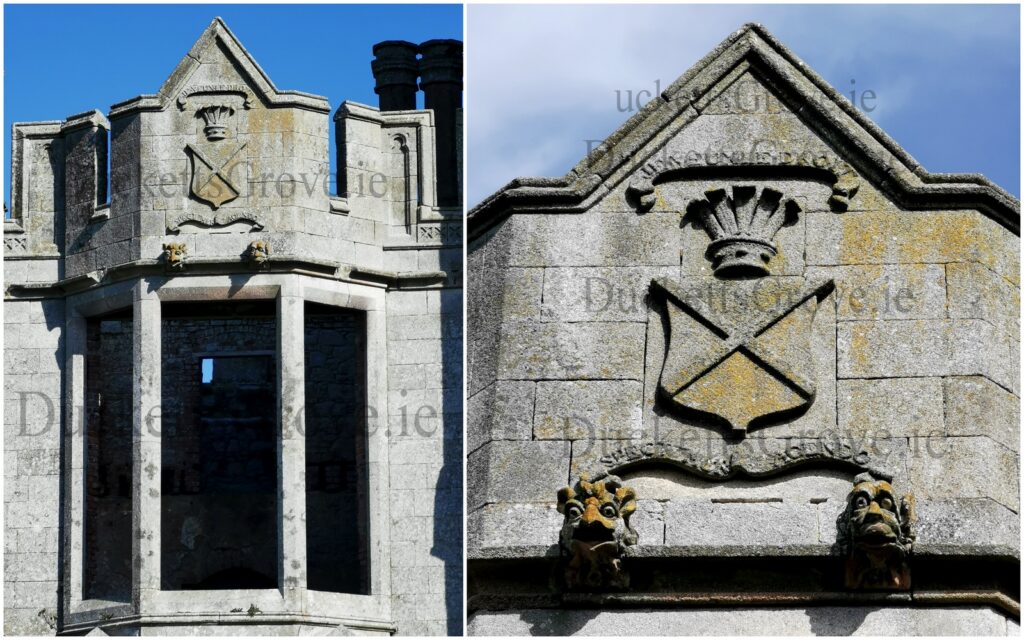
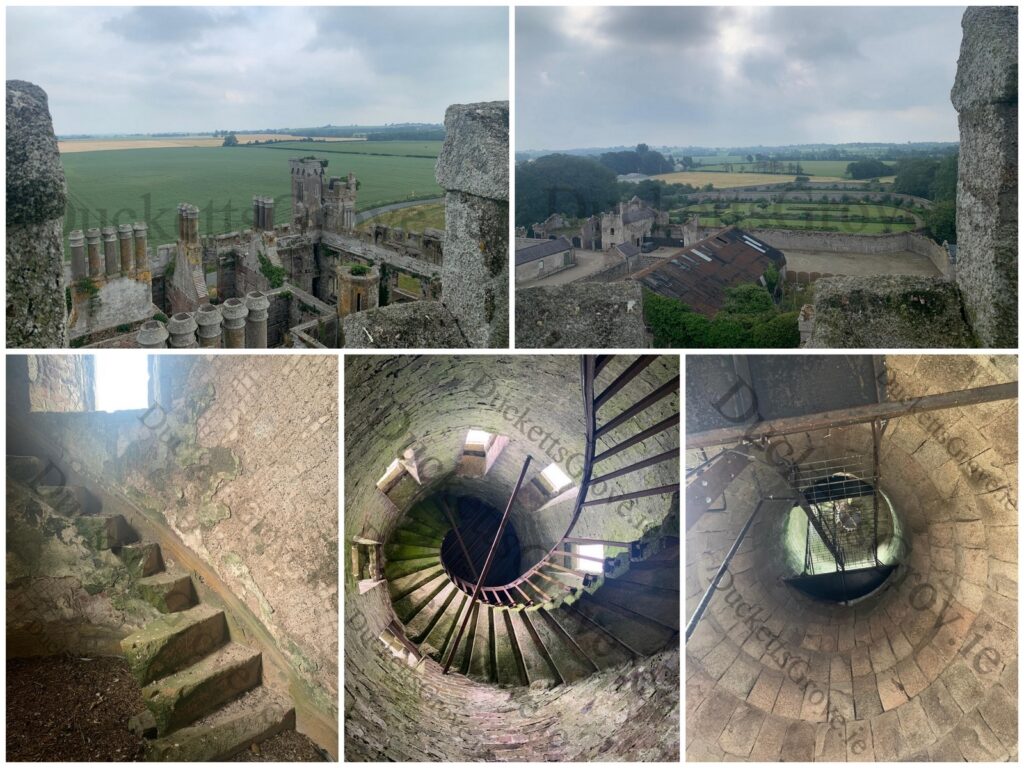


John MacDuff Derick and ‘The Towers’ Gate Lodge
During the same period, circa 1845, John MacDuff Derick Architect also designed ‘The Towers’, the main gate lodge of Duckett’s Grove. It was built by Messrs Kelly and Kinsella, contractors, taking two years to complete the work. This gate lodge is one of the most elaborate castellated gate lodges in Ireland and is of considerable architectural importance. It is one of the final domestic designs by John MacDuff Derick in Ireland. It comprises of two centre towers with crenellations, lancet and mullioned windows, and has two impressive and empowering archways with two distinct avenues. The towers are of unequal eight, one being fifty feet high and the other forty-three feet. The taller tower originally contained a characteristic continuous spiral stairway, leading to fireproof apartments above. Above the central archway, a level flat or terrace of solid masonry was also contained and composed of Carlow flags with drips after the manner of Rosslyn Castle, England. (drips: hooded mould or dripstone – an external moulded projection from a wall over an opening to relieve rainwater, introduced into architecture in the Romanesque and Gothic period).
The centre archway featured a portcullis over which is found a large coat of arms with a Latin inscription “Spectemur Agendo” meaning “Let us be judged by our Acts”. This centre archway was used as the entrance for the Ducketts and their Royal and Gentry visitors, while the archway to the left was used as the workers’ and deliveries entrance. To the left of the workers’ and deliveries entrance, a small arched gateway contains a small crest with a French inscription, “Je Veux Le Droit”, meaning “I want the right”, which refers to “the right” with regards to justice and the law. The Towers gate lodge remains in private ownership and is a protected structure located at Russellstown Cross, Palatine, Co. Carlow on the L1009.
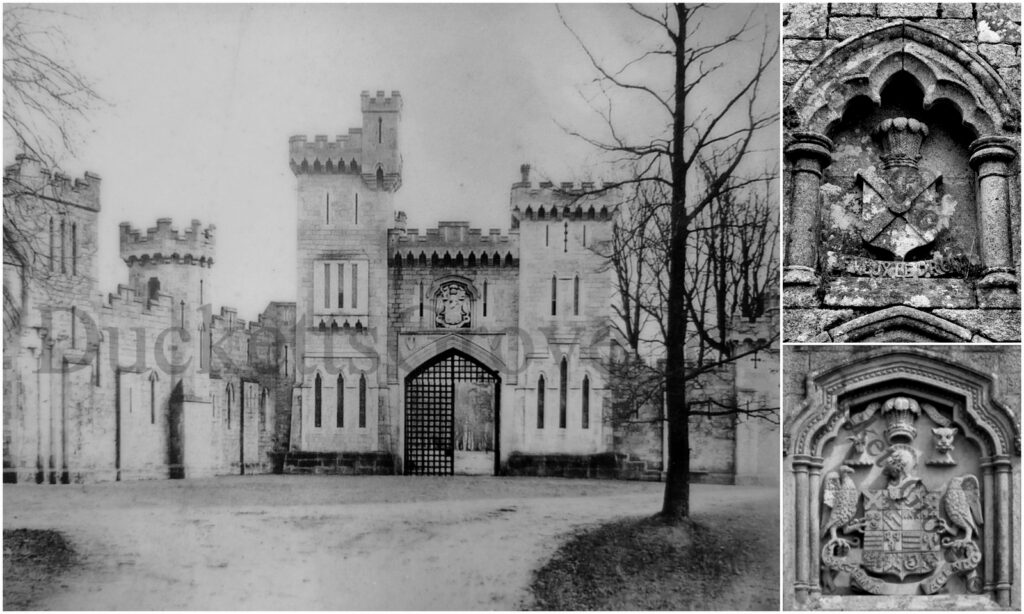
‘The Towers’ and the passing of time

John MacDuff Derick Architect (1810-1859)
John MacDuff Derick Architect was the son of James Derick of Ballymote, Co. Sligo, and was descended on his father’s side from an old Connaught family and on his mother’s from the Macduffs, Earls of Fife. He attended Trinity College, Dublin, was a pupil of Sir John Soane and travelled in Normandy, the south of France and Italy. His professional connection with Oxford began in the 1830s, when he designed the boatmen’s floating chapel on the Oxford Canal in the Grecian style. In 1836 he married Elizabeth Jane Rathbone at St. Giles in The Fields, Surrey, England and they had two sons. While his principal works in England appear to date largely from the 1840s, it was during the 1850s that Derick was active in Ireland, where he is known to have designed three churches and the castellated gate lodge (‘The Towers’) at Duckett’s Grove, Co. Carlow. In 1852 he re-married Elizabeth Joyce Fulcher at St. George Hanover Square, London, England and they had one son. In the same year he exhibited two designs at the National Exhibition in Cork. He was elected an associate of the Royal Hibernian Academy on 13th October 1854.
His obituary states that Derick retired early from practice on account of domestic afflictions and failing health but was forced to resume his profession after suffering unforeseen financial losses. In 1858 he emigrated to America, where he died in New York on 20th September, 1859. He is described as modest and cheerful, honourable and generous and is said to have been a friend of Agustus Welby Northmore Pugin and some of the leading artists and writers of his day.
(Source of reference on John MacDuff Derick is courtesy of Dictionary of Irish Architects www.dia.ie and Manchestervictorianarchives.org.uk)
Duckett’s Grove – An Architectural Heritage re-designed by Architects Thomas A. Cobden circa 1745 and John MacDuff circa 1845
While the Gothic design of Thomas A. Cobden and the Renaissance design of John MacDuff Derick Architects were more statements of wealth and grandure than displays of structural or engineering solutions, Duckett’s Grove has left the townsland of Rainestown and the County of Carlow with significant architectural heritage which must be sensitively nurtured, preserved and protected.
Although much of the nineteenth century statuary and grandeur is now lost and gradual decay continues to create a more medieval yet romantic effect, remanence of the designs of Thomas A. Cobden and John MacDuff Derick is clearly visible today.
However, with the passing of time, and without effort, nature continues to reclaim this magnificent architecture as its own. Duckett’s Grove continues to be one of the most beautiful and photographed structures in Ireland and remains majestically nestled in the rural landscape of Rainestown, Co. Carlow as a “place of natural beauty and a sanctuary of solace.”
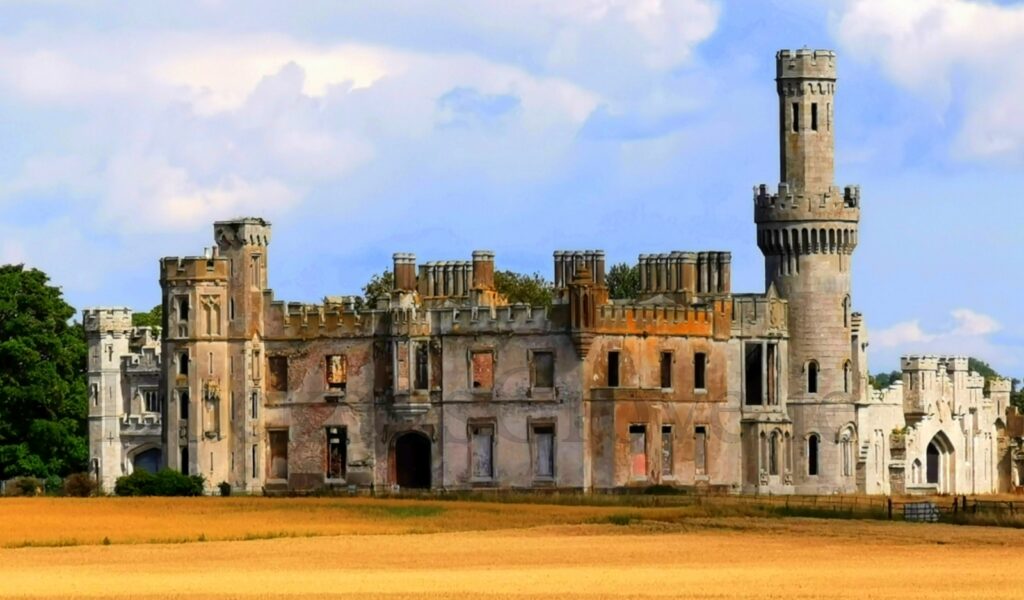
Article by J. Doyle – Founder, Owner and Administrator of DuckettsGrove.ie
